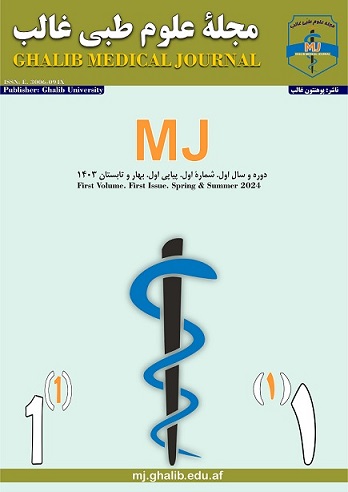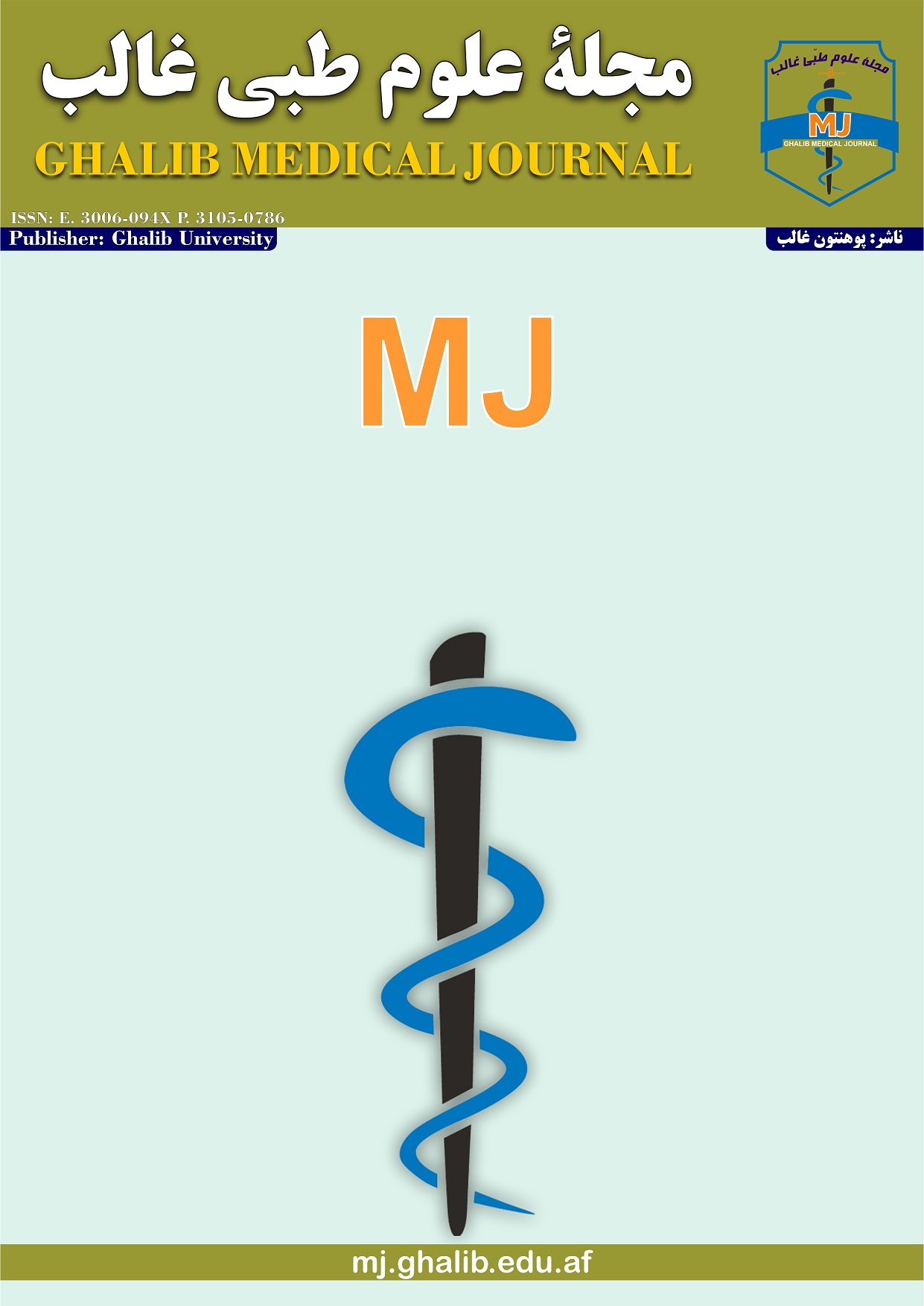بررسی میزان شیوع سینوزیت مگزیلا با منشأ دندانی نزد مریضان مراجعهکنندۀ شفاخانۀ ملّی تخصصی ستوماتولوژی کابل در سال 1399
DOI::
https://doi.org/10.58342/ghalibMj.V.1.I.1.3واژهگانِ کلیدی:
سینوس مگزیلا، منشأ دندانی، شفاخانة ملّی تخصصی ستوماتولوژی کابل، اختلاطات، تداویچکیده
زمینه و هدف: سینوزیت واقعهیی است که در همه سنها بهوجود آمده و میتواند در هر دو جنس قابل دید باشد، انجام این تحقیق در افغانستان، شهر کابل شفاخانۀ ملّی تخصصی ستوماتولوژی دیپارتمنت جراحی وجه فک در سال 1399 صورت گرفت. هدف کلی تحقیق بهدستآوردن معلومات کافی در مورد بهمیانآمدن سینوزیت، اعراض و علایم، شیوع و طرق تداوی، میزان واقعات و میتود تداوی سینوزیت منشأ دندانی است.
روش بررسی: تحقیق انجامشده توصیفی (Descriptive) از نوع Case Series است؛ که در طول ۱۲ ماه در شفاخانۀ ستوماتولوژی بالای ۷۷۲۰ مریض با لوحههای مختلف به سرویس جراحی وجه فک مراجعهکننده صورت گرفت، از جمله ۱۴ مریض با لوحۀ سینوزیت سینوس مگزیلا داخل بستر گردید، که فیصدی شان ۰٫۱۸ فیصد را تشکیل میداد.
یافتهها: واقعات سینوزیت نزد طبقۀ ذکور بیشتر بوده، در حدود ۵۷٫۱٪ است، اما نزد خانمها 42٫۹٪ دریافت شده است. بیشترین واقعات در سنین بزرگتر از ۱۵ سال بوده، که حدود ۷۸٫۶٪ میشود؛ ولی در سنین پایینتر از ۱۵ سال کمتر دیدهشده، حدود ۲۱٫۴٪ است، بیشتر مریضان (۷۸٫۶ ٪) به لوحۀ سینوزیت حاد به شفاخانه مراجعه نمودهاند. اما سینوزیتهای مزمن ۲۱٫۴ فیصد را تشکیل میدهد. بیشترین روش تداوی مریضان بستری سینوزیت را Fistulectomy تشکیل داده، که حدود ۴۲٫۹٪ شده و به تعقیب آن عملیات Cald Well Luc بوده، که ۳۵٫۷٪ میشود و یک تعداد فیصدی کم مریضان (۲۱٫۴ ٪) صرف نسخه تجویزشده است؛ این در حالی است که در کشورهای پیشرفته بیشترین عملیات جراحی را عمل با استفاده از اندوسکوپ تشکیل میدهد.
نتیجهگیری: این تحقیق شیوع و تداوی سینوزیت با منشأ دندانی را بهخصوص میان مردان و کاهلان همراه با پتالوژی پیشرفتۀ دندانی نشان میدهد و پیشنهاد مینماید تا تداوی را از نوع Cald Well Luc به نوع تداوی جراحی اندوسکوپیک به اساس اینکه نتیجۀ بهبود این تخنیک بهمراتب بیشتر بوده و میزان ابتلا را هم کم میسازد، مبدل گردد. در ضمن تحقیقات بیشتری جهت راه معقول دیگر برای کنترول خوب و بهبود بیشتر برای این حالت، نیاز است.
مراجع
Miloro M, Ghali G, Larsen PE, Waite PD. Peterson's principles of oral and maxillofacial surgery: Springer; 2004.
Malik NA. Textbook of oral and maxillofacial surgery: JP Medical Ltd; 2012.
Brook I. Sinusitis of odontogenic origin. Otolaryngology—Head and Neck Surgery. 2006;135(3):349-55.
Longhini AB, Ferguson BJ, editors. Clinical aspects of odontogenic maxillary sinusitis: a case series. International forum of allergy & rhinology; 2011: Wiley Online Library.
Patel NA, Ferguson BJ. Odontogenic sinusitis: an ancient but under-appreciated cause of maxillary sinusitis. Current opinion in otolaryngology & head and neck surgery. 2012;20(1):24-8.
Mehra P, Jeong D. Maxillary sinusitis of odontogenic origin. Current allergy and asthma reports. 2009;9(3):238-43.
Gosau M, Rink D, Driemel O, Draenert F. Maxillary sinus anatomy: a cadaveric study with clinical implications. The Anatomical Record: Advances in Integrative Anatomy and Evolutionary Biology: Advances in Integrative Anatomy and Evolutionary Biology. 2009;292(3):352-4.
Hajiioannou J, Koudounarakis E, Alexopoulos K, Kotsani A, Kyrmizakis D. Maxillary sinusitis of dental origin due to oroantral fistula, treated by endoscopic sinus surgery and primary fistula closure. The Journal of Laryngology & Otology. 2010;124(9):986-9.
Lopatin AS, Sysolyatin SP, Sysolyatin PG, Melnikov MN. Chronic maxillary sinusitis of dental origin: is external surgical approach mandatory? The Laryngoscope. 2002;112(6):1056-9.
Bomeli SR, Branstetter IV BF, Ferguson BJ. Frequency of a dental source for acute maxillary sinusitis. The Laryngoscope. 2009;119(3):580-4.
Nishimura T, Iizuka T. Correlation of Bone Scintigraphy with Extent of Inflammation and Clinical Symptoms in Odontogenic Maxillary Sinusitis. Asian Journal of Oral and Maxillofacial Surgery. 2003;15(2):90-5.
Pokorny A, Tataryn R, editors. Clinical and radiologic findings in a case series of maxillary sinusitis of dental origin. International forum of allergy & rhinology; 2013: Wiley Online Library.
Brook I. Microbiology of acute and chronic maxillary sinusitis associated with an odontogenic origin. The Laryngoscope. 2005;115(5):823-5.
Chemli H, Mnejja M, Dhouib M, Karray F, Ghorbel A, Abdelmoula M. Sinusites maxillaires d’origine dentaire: traitement chirurgical. Revue de Stomatologie et de Chirurgie Maxillo-faciale. 2012;113(2):87-90.
Costa F, Emanuelli E, Robiony M, Zerman N, Polini F, Politi M. Endoscopic surgical treatment of chronic maxillary sinusitis of dental origin. Journal of Oral and Maxillofacial Surgery. 2007;65(2):223-8.
چاپ شده
ارجاع به مقاله
شماره
نوع مقاله
مجوز
حق نشر 2024 منیر احمد ابراهیمخیل, عبدالعلی رسولی

این پروژه تحت مجوز بین المللی Creative Commons Attribution 4.0 می باشد.










